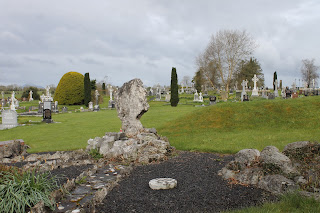There is one thing
that Ireland is know for that sets it apart from England, Scotland, and Wales
in my mind. It is the faithfulness of the people of the Roman Catholic faith.
They went through a lot, especially in the last couple of hundred years, to maintain
their faith, their traditions, and, indeed, their way of life. If you visit
Ireland now, you will find that many young people do not attend church, and
this is not just those of the Catholic faith, but of the other churches in
Ireland. The younger generation have demanded that Ireland be brought into the
twenty-first century, even if it is kicking and screaming. This includes
bringing peace to the island, especially in Northern Ireland.
Northern Ireland has
many more people of Protestant faiths, but, to me it seems that they don’t have
the same number of ancient or medieval ruins as reminders of how ancient the
land is and the people who were first there. That being said, the Republic is
home to a great number of abbeys that are no longer used and haven’t been for
hundreds of years. However, there are some that have been renovated to use as
tourist destinations and some for use by the surrounding neighbourhood.
Ballintubber Abbey is one of the abbeys that combine the two purposes.
Ballintubber Abbey has
been there in one form or another since 1216. Prior to that, there was a
tradition that St Patrick baptised people in the small river at the back of
where the Abbey now stands. There is also a trail leading from there to the top
of Croagh Patrick where St Patrick is reputed to have fasted for
forty days in the mid 400s AD. This mountain is the third tallest mountain in
County Mayo. The trail was used in the past for a pilgrimage to the top of the mountain
when pilgrimages to Jerusalem were discontinue when the Saracens recaptured the
Holy Land. Eventually, even these pilgrimages petered out.
The Abbey is
surrounded by a magnificent cemetery. There are very old headstones as well as
modern ones. The Abbey also has a Way of the Cross which faithful Catholics
follow, especially in time for Easter. There is a Rosary Way, an underground
crib, and a small museum. I did not get a chance to visit the museum as our
schedule had to be kept.
The Abbey was severely
damaged during the Cromwellian years, but the people still continued to meet on
the grounds throughout the years. Just prior to 1966, a new roof was put on the
roofless building in time for the 750th anniversary. Recently, there
have been renovations on the building and its interior in time for the 800th
anniversary which was or is being held this year (2016).
This building costs a
lot of money to restore and maintain. In order to raise funds, the Abbey is
open to tourists who are given a tour of the cemetery, along with the Way of
the Cross and the Rosary Way, and inside the building itself. Pilgrimages are
held at six times a year, Easter, and then once in May, June, July, August, and
December. These pilgrimages are the same as is described above. Ballintubber
Abbey is a popular choice of location for weddings of both local people and
celebrities. Once celebrity wedding in 2001 was for Irish actor Pierce Brosnan
and his wife, American journalist Keely Shay Smith. For those of you who don’t
know who Pierce Brosnan is, he had the title role of Remington Steele in the
American TV series of the same name, and he also played James Bond in a number
of James Bond movies.
I enjoyed visiting
Ballintubber Abbey as I do have an interest in history and in religious
history. I would like to go back to study the Abbey and the surrounding area
more and to collect the stories that abound about St Patrick.






















































